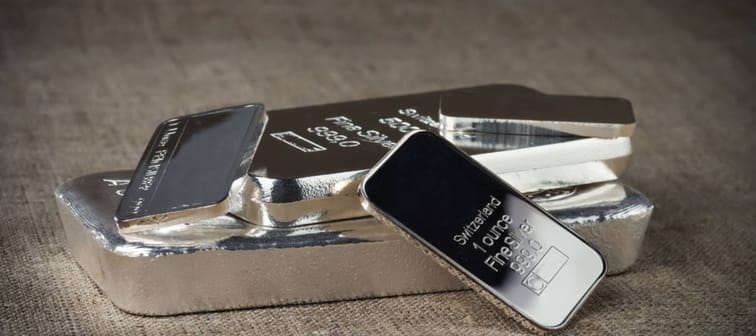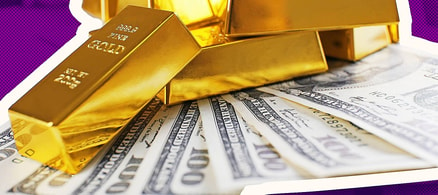The basics of silver investing
Silver isn't a traditional investment since it doesn't generate a product or service. Silver has value in and of itself, as both a precious and an industrial metal. But it's otherwise inert. It doesn't produce anything, generates cash flow, or provide a steady income.
Silver is more in the realm of speculation than investment. If you choose to invest in silver, you should approach it with the mindset of a speculator.
That can be not easy to discern, especially when the price of silver seems to be rocketing to infinity. Most times and in most markets, silver goes flat, trading in a very tight price range.
Meet Your Retirement Goals Effortlessly
The road to retirement may seem long, but with WiserAdvisor, you can find a trusted partner to guide you every step of the way
WiserAdvisor matches you with vetted financial advisors that offer personalized advice to help you to make the right choices, invest wisely, and secure the retirement you've always dreamed of. Start planning early, and get your retirement mapped out today.
Get StartedIs silver a good investment?
We answer this question by looking at the history of the price of silver. Throughout the centuries, silver wasn't an investment at all. People used silver as actual money. People used it in everyday transactions, while gold was primarily held and used by the wealthy. Some people refer to silver as “the poor man's gold.” And because it was a monetary metal, its value remained relatively stable.
Until the 1960s, the price of silver stayed below $1 per ounce. That was one of the basic reasons the U.S. government commonly minted silver coins. However, as silver began to rise in price, the U.S. government withdrew silver from American coinage under the Coinage Act of 1965.
After being demonetized, silver rose in price. As the price increase became more intense, it began to take on the characteristics of an investment.
At the beginning of 1970, the price of silver was $1.80. By 1980, the silver price peaked at $49.45 per ounce. This represents an incredible price increase of more than 2,700% in a decade. But in just five months more, the price plummeted to less than $11.
Ironically, silver regained that price level only 39 years later and again could not sustain it for long. Through the years, silver experiences periodic and dramatic increases that maintain its reputation as an investment.
More than anything, however, silver seems to be a commodity that either performs spectacularly or languishes and does nothing.
More: How to invest 100k: 8 best ways to invest money right now
Silver price action over time
The price of silver languished at around $5 per ounce from 1995 through the end of 2003. If you had held silver during that eight-year time frame, you would have had virtually no return on your money.
However, in 2004 silver began to turn upward, rising to close to $16 per ounce at the beginning of the financial crisis in 2007. But even with the onset of the crisis, the price fell by nearly 50% by the end of 2008.
Then it began the second major upturn in price that confirmed silver as a legitimate crisis investment. From a price level of less than $9 in late 2008, it reached nearly $50 per ounce in 2011. That's a return of more than 500% in the space of less than three years.
By the end of 2014, the price declined to the $16 range, even falling as low as $12 in early 2020. But in March 2020 (the early days of the COVID-19 pandemic), silver spiked once again up to nearly $30 per ounce.
Since then, the price has slowly retreated throughout 2021 and 2022. As of writing, silver's price per ounce is nearing the $20 mark.
Stop overpaying for home insurance
Home insurance is an essential expense – one that can often be pricey. You can lower your monthly recurring expenses by finding a more economical alternative for home insurance.
SmartFinancial can help you do just that. SmartFinancial’s online marketplace of vetted home insurance providers allows you to quickly shop around for rates from the country’s top insurance companies, and ensure you’re paying the lowest price possible for your home insurance.
Explore better ratesInvesting in gold vs. investing in silver
Gold and silver are often used interchangeably since they have similar histories and price performance. Generally speaking, the prices of the two rise and fall in tandem.
For that reason, it may not matter which you hold during a time of financial turbulence.
Traditionally, gold has been considered the more common investment metal, probably since it's still considered to be something of a monetary asset. After all, the major central banks of the world all hold substantial reserves of gold.
In recent decades, silver has become more of an industrial metal than a monetary one. The gold/silver ratio has traditionally been between 50-to-1 and 80-to-1 but grew to nearly 115-to-1 in early 2020.
More: The case for silver vs gold
How to invest in silver
There are multiple ways you can invest in silver. This includes purchasing the metal itself and taking possession of it. Or investing in paper assets connected to silver, such as stocks, funds, and even silver streaming companies.
- Buy silver mutual funds, ETFs and ETNs
- Buy silver bullion
- Buy silver mining stocks
- Buy silver streaming companies
- The basics of silver investing
Buy silver mutual funds, ETFs and ETNs
If you're not keen to own silver bullion itself, you can own the metal through paper assets tied to it.
Silver mutual funds invest primarily in the stock of companies that mine silver. It's not the equivalent of owning the metal itself, but rather participating in the industry that produces it. A silver mutual fund holds a portfolio of stocks in such companies. Those stocks generally parallel silver price levels. You can buy silver mutual funds through most stock brokers, like Merrill Edge.
A silver exchange-traded fund (ETF) is a way to hold silver bullion itself, except you do it through a fund. An example is the iShares Silver Trust (SLV). This fund generally traces the price of silver, largely because it holds the metal in the trust. You won't have direct ownership of the metal itself. Instead, you own shares of the ETF that owns the silver. You can purchase ETFs through most online brokers, including Ally Invest.
Exchange-traded notes (ETNs) are unsecured debt securities that track an underlying silver index. Unlike bonds, they don't pay interest. Instead, the price of the ETN fluctuates with the value of silver. ETNs trade on major exchanges, much like stocks. Since ETNs don't hold silver or even stock in silver mining companies, investing in securities is best for those more experienced in silver investing.
More: 9 best investment apps for beginners right now
Buy silver bullion
This is the most direct way to invest in silver. By buying silver bullion, you actually take possession of the metal, even holding it “old school” in coin form.
- Coins are probably the most convenient way to hold silver bullion. For example, you can buy a one-ounce pure silver coin, such as the American Silver Eagle or Canadian Maple Leaf.
- If you prefer to invest in larger quantities of silver, you may want to consider silver bullion bars. They can be purchased in quantities ranging from one ounce to 100 ounces. But you should be aware that silver bullion bars aren't traded as easily with private parties or coin shops as coins are.
- You can buy silver bullion coins and bars at local coin dealers or from national precious metals dealers. Goldline, McAlvany ICA, and JM Bullion are some of the largest.
Be careful when buying silver coins! Many coin dealers will attempt to persuade you to buy numismatic silver coins, which are a different commodity entirely. While silver bullion coins are playing on the price of silver itself, numismatic coins get their value primarily from the rarity.
For example, many U.S. silver coins from the 1800s command prices in excess of $1,000, which is nearly 40 times its silver content value. That's something closer to investing in the artwork than it is in silver itself.
Complicating numismatics is the fact that there is significant disagreement over the grading and value of each coin. One dealer values a coin at $1,000 while another determines it to be worth only $750. Numismatic coins are suited only to those who are experts in that field.
Buy silver mining stocks
Another way to invest in silver is to purchase stock in the companies that mine it. Instead of purchasing a portfolio of stocks through a mutual fund, you are buying them individually.
- Silver mining stocks are probably the most speculative way to participate in the silver market. Though they generally parallel the price performance of silver and often exceed it, they also involve risks that are inherent in any company.
- Many things impact the prices of stocks. These include international disturbances, environmental catastrophes, foreign government regulation or nationalization, labor unrest, and international currency fluctuations.
- But as mining companies, they also have risks specific to mining activity. That includes high capital cost, the risks of mine exhaustion, an oversupply of the metal, and even the possibility of developing a mine only to find minimal or no silver.
Some of the best silver mining stocks include First Majestic Silver Corp (AG), Pan American Silver Corp (PAAS), and MAG Silver Corp. (MAG).
Buy silver streaming companies
Silver streaming companies are like buying royalties in silver mining companies. These companies are not actually involved in silver mining directly. Instead, they provide financing to the companies that do. They'll be paid back, often by being able to buy silver from their mining partners at well below the going rate. That allows them to sell the discounted silver at a full market price and collect the difference as a profit.
Like silver mining company stocks, silver streaming company stocks usually track the price of silver. However, they underperform silver if their financing arrangements go sour or there are other difficulties with the mining companies they're connected with.
Pros and cons of investing in silver and other precious metals
Pros
- As we mentioned earlier, the silver price has remained relatively static for most of history. But like the price of gold, it tends to rise during times of economic or financial instability. That occurred in the 1970s and during the Financial Meltdown of 2008. And it seems to be happening again now with the coronavirus pandemic.
- Silver is highly speculative and usually goes up only when traditional investments like stocks and bonds are down. For that reason, consider it as an alternative investment (or speculation) to offset losses in traditional assets during times of financial turbulence.
- Because the silver price can crash just as quickly as it takes off, it's best to limit your portfolio holdings to no more than a few percentage points.
- One certain thing is that silver should not be considered a long-term growth asset, such as you might hold in your retirement portfolio. While it tends to perform well when stocks are falling, silver's long-term prospects aren't a good fit with long-term investing.
Cons
- The major risk of investing in silver is price instability. As we've seen, the price of silver can rise dramatically but reverse course just as quickly.
- If you buy silver during a big run-up in price — which unfortunately is what the average investor does — you may be setting yourself up for a major decline.
- Still, another risk factor is that, unlike gold, the price of silver is heavily affected by industrial demand. Silver's price performance may be poor in case the industrial demand is suppressed by the same factors that are causing instability in the financial markets, .
- If you choose to invest in silver bullion coins or bars, the transaction fees can be high — 5% to 10% is not uncommon. If you're paying that upon both purchase and sale, the price will need to rise substantially just for you to recover your transaction costs.
Investing in silver can be challenging
Silver is unquestionably one of the more difficult commodities to invest in. It's hard to know when to buy and when to sell. Most important, silver isn't the kind of investment that provides reliable capital appreciation or even income like interest or dividends.
If you do choose to invest in silver, the best way is probably through a silver ETF. This allows you to participate in the metal itself with low fees and the ability to buy in and sell out quickly, and can easily be managed by low-fees brokers like E*TRADE. But you won't need to be concerned with taking possession of the metal or dealing with the uncertainties of silver mining stocks.
No matter what, keep your investment in silver at a low single-digit percentage of your total portfolio. A 5% position may be enough to give you impressive returns during a financial meltdown, without crushing your portfolio if the price goes against you.
Read about what else you can invest in:
- How to invest in lab-grown meat: 5 best companies to invest In
- LGBTQ+ friendly investments: what they are & how to find them
- What is fractional share investing?
- Oil vs. renewable energy stocks: Which should you invest in today?
Sponsored
Follow These Steps if you Want to Retire Early
Secure your financial future with a tailored plan to maximize investments, navigate taxes, and retire comfortably.
Zoe Financial is an online platform that can match you with a network of vetted fiduciary advisors who are evaluated based on their credentials, education, experience, and pricing. The best part? - there is no fee to find an advisor.










